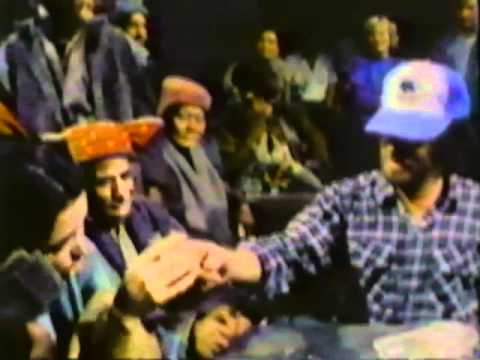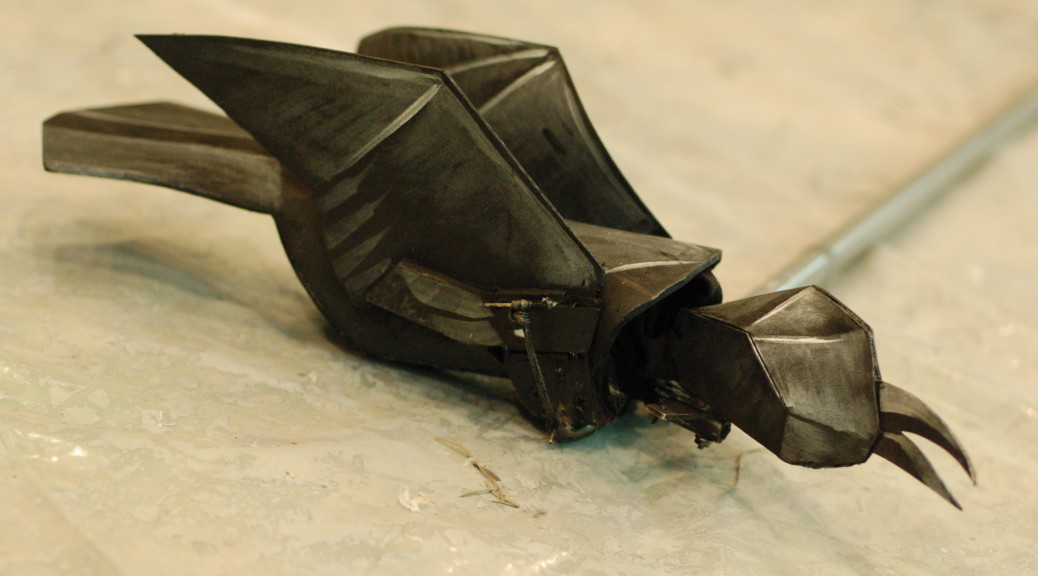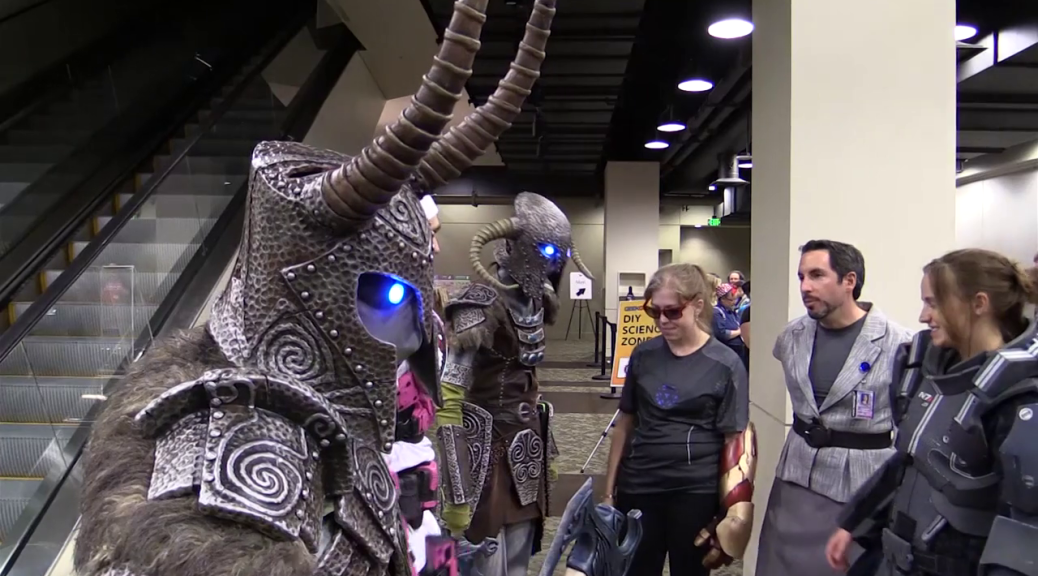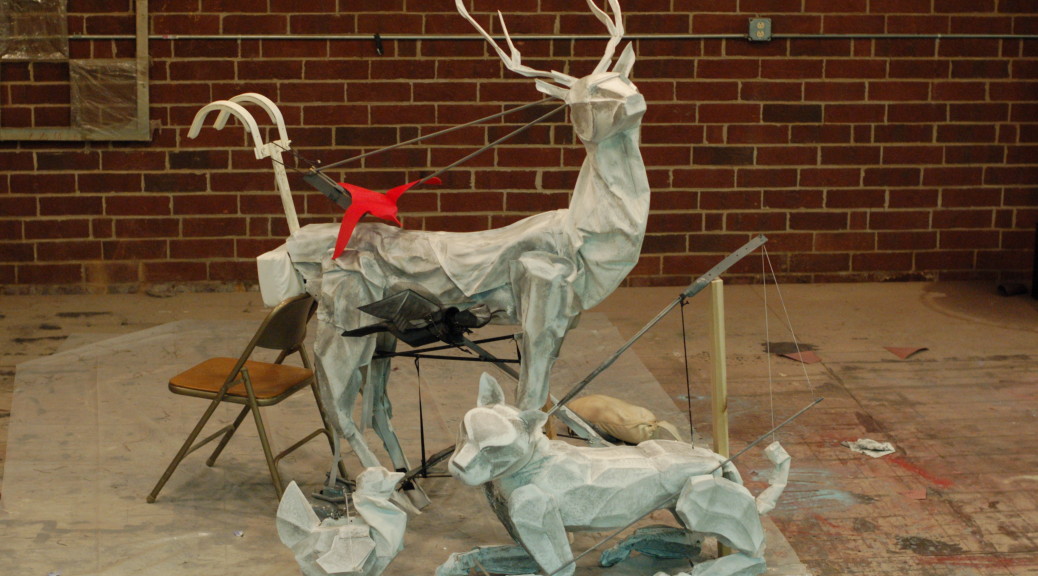If you have an hour to spare, this PBS special from 1981 is all about the making of Raiders of the Lost Ark. It’s quite in-depth and full of a lot of the practical and technical aspects of creating a film as ambitious as this one was. While this documentary does not touch on props much, it is fascinating to see all the practical challenges which needed to be solved in the days before computer graphics took over everything.
Tag Archives: video
Crow Puppet
My major project for the past few months involved engineering and constructing a number of animal puppets for Triad Stage’s production of “Snow Queen”. I wrote about the white-tailed stag last week. One of the most complicated puppets in terms of motion and movement was the crow. He also had the most stage time out of all the puppets, appearing on his own in several scenes. I began work on him shortly after beginning the stag, so that I could have plenty of time to develop the means to have a single puppeteer perform all the actions he needed to perform.
You can see a bit of the “evolution” of the puppet’s mechanisms in this video.
The major difference between the prototype puppet in the video and the final puppet was that I switched the pole to connect on the side rather than from behind. It gave the puppeteer much more control over the puppet by letting him manipulate the orientation of the crow’s body by twisting the main control pole, rather than having to stoop and squat.
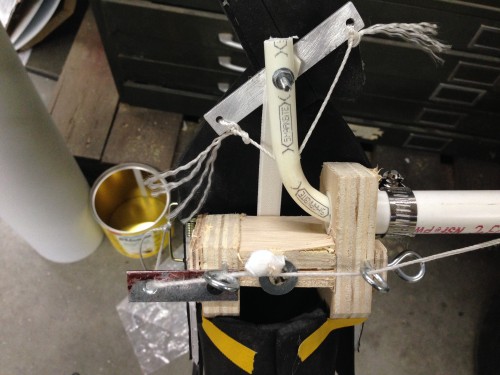
As you saw in the video, the head and neck were controlled by an inner pole which was free to rotate on its own. Strings ran inside which could turn a bar that held the head.
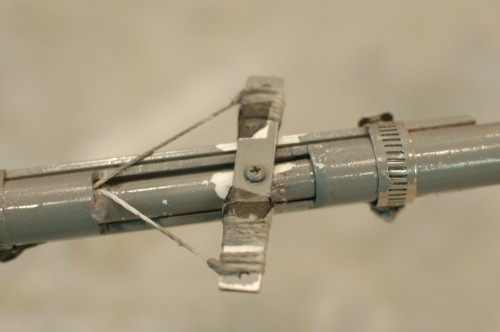
At the other end of the control bar was a similar bar that held the other ends of these strings. The puppeteer could both swing the bar back and forth and rotate the inner pole with just one hand. The other hand was free to flap the wings.
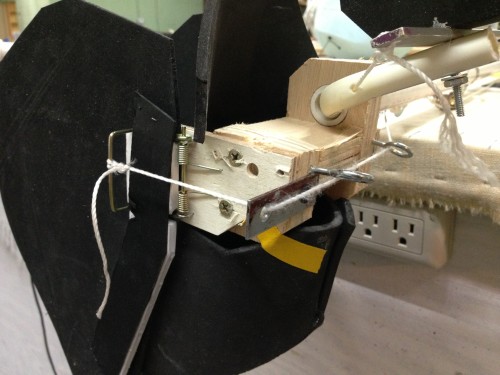
If you look closely, you will see the wings were actually attached to mousetraps. Pulling a string moved the wings down, and the springs in the mousetrap moved the wings back up when the string was released.
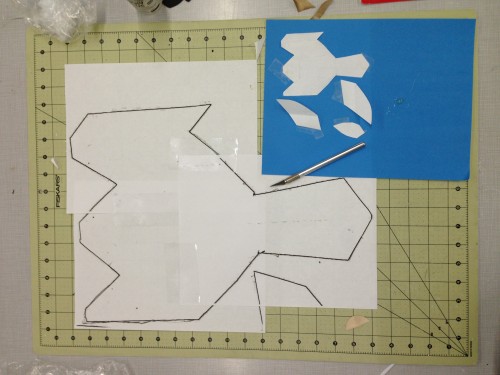
The pattern for the crow’s body was developed in a small prototype by the puppet designer, Bill Brewer. I enlarged this pattern and cut it out of black EVA foam sheets. I came up with a pattern for the head and beak to match the look; like the other puppets in the show, the appearance was not meant to be realistic, but was stylized to make the crow look like he was cut and folded out of sheets of paper.
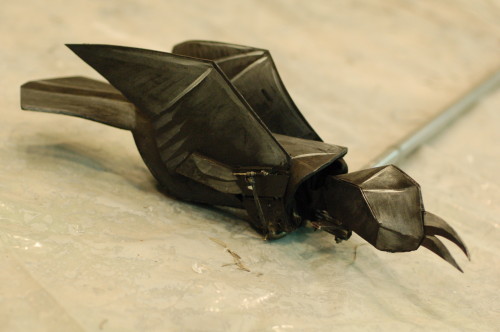
The solid black crow tended to disappear when on stage, so he was given a final paint job by the scene designer, Howard Jones. He accentuated the flat planes and folds on the crow with white and silver paint, helping make the crow “pop” against the background.
Friday Fun Time Link-o-Rama
Chrix Designs shows how she made a staff of Kraken; it’s a staff with an orb surrounded by octopus tentacles. I found her technique for making the sculpted tentacles pretty interesting.
Kris Compas shows how to turn on a drill press in this two-part tutorial (see part 1 and part 2). Now, a drill press motor isn’t made to withstand the lateral pressure from full-scale turning of hardwoods , but Compas is turning doll-house furniture pieces out of basswood. This seems like a fine technique for all that small-scale kind of stuff you might need to do.
For Nic Howard, nothing is safe when it comes to molding and casting. She shows how she molds everything from bookplates to cookies in order to have a library of decorative castings to attach to objects.
Cosplay Boom interviews Bill Doran of Punished Props in this video. Doran talks about how he got started and what he loves about making props.
Finally, American Horror Story’s two assistant props masters take you behind-the-scenes for a look at some of their props in this video:
White-tailed Stag
The majority of my time this past autumn was spent working on puppets for Triad Stage’s production of “Snow Queen”. The play is an original retelling of the Hans Christian Anderson tale, set in the Appalachian Mountains with bluegrass music.
The animals (other than the two birds) were designed to look like they were constructed from cut and folded paper. Bill Brewer, the puppet designer, came up with the range of motions he wanted the puppets to have. Each puppet only had one puppeteer to operate it, which is tricky when the puppets are this large and manipulated by actors rather than trained puppeteers. We worked together to distill their movements down to the simplest motions so their moments on stage would be evocative and magical.
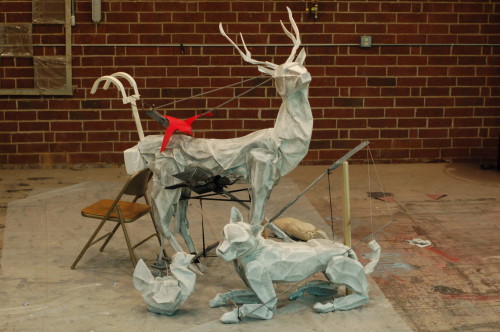
The stag had the most logistical challenges, so I began work on him first. The main challenge was that the lead actress rides him around on stage, so it needed to support her weight and remain comfortable for the operator to carry her while still working the puppet. I used a marching band snare drum harness to attach the puppet to the operator. We used these out at the Santa Fe Opera this past summer for a similar purpose, so I already knew it was the best option for comfortably distributing the weight over the operator’s body while keeping a strong and stiff connection to the puppet.Â
You can watch the evolution of the skeleton and mechanisms in the video below:
It took me about a month and a half to get the movement right (I was working on the other puppets at this time as well, and we produced a whole other show within that time frame as well). My goal was to have this skeleton ready for the first week of rehearsal so the actors could begin working with it and discovering what it could do.
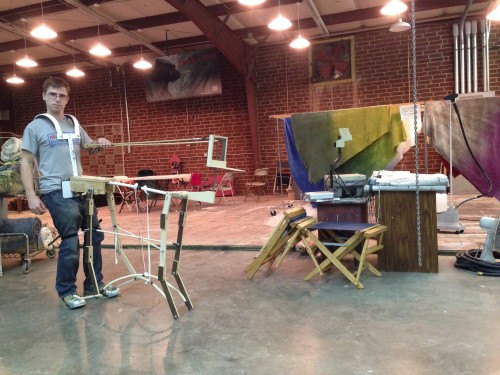
When the puppets were not being used in rehearsal, I took them back to start adding the three-dimensional bodies. It was vital that the actors used the puppets in rehearsal; the evolution of the puppet scenes was shaped dramatically by the discoveries of how the puppets moved and reacted.
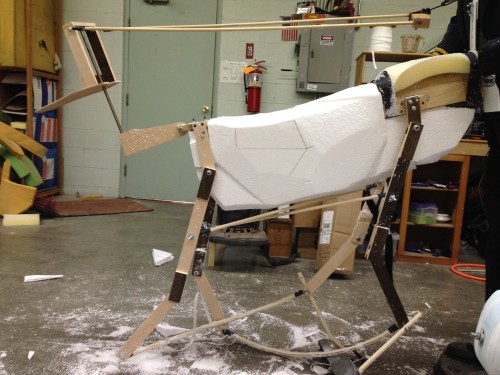
For the solid parts, I attached chunks of EPS foam and carved them into shape.
To get the “folded paper” appearance, I laid some pieces of Wonderflex over top of the foam. Wonderflex is a plastic sheet which becomes formable at a very low temperature; you can let it drape or fold it like fabric, and when it cools, it retains that shape.
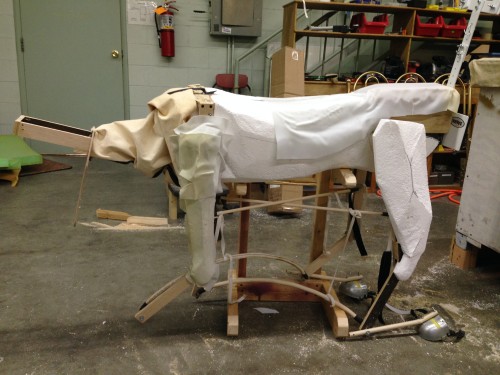
For the neck, I needed a much more flexible material, and after some experimentation, found a type of fabric which matched the appearance of the rest of the stag, but would allow the puppet to retain its full range of motion.
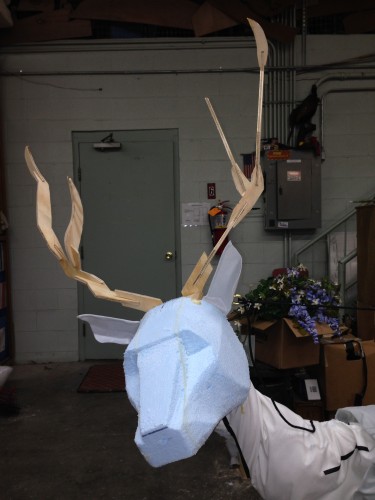
The head itself was carved by Brewer. We played around with a few designs for antlers, and ended up making them out of several interlocking segments. The ears were cut and shaped from more Wonderflex.
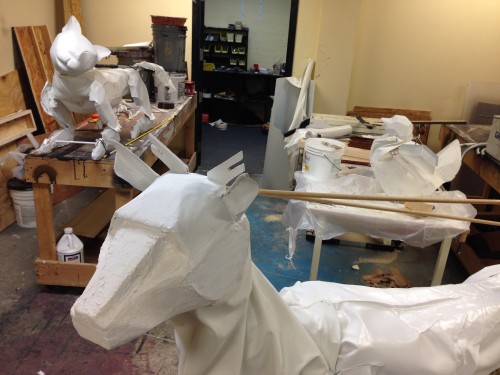
By that point, we were already loading into the theater, so the long task of filling, sanding and priming was done there. After  base-coating the puppets to a uniform white color, they were shaded with grey and silver paint to accentuate the flat plains and folds. Most of this was done by Howard Jones, the scenic designer on the show.
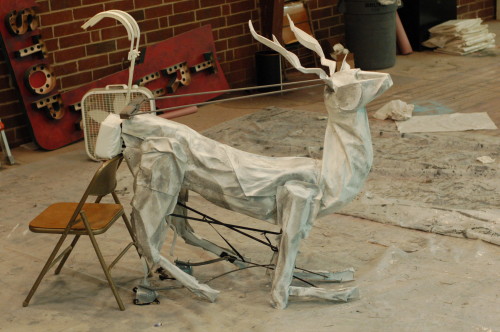
First Links of 2014
Welcome back, everyone! I hope you all had an enjoyable holiday and are ready for the new year. You may have noticed this site has a brand new look. I am still working out all the bugs and kinks, but all of the articles and information are still there. So feel free to check it all out, and check out the following links as well:
If you are a fan of the show Parks and Recreation, you may enjoy this oral history of the “Cones of Dunshire” board game which appeared a few episodes ago. The prop department worked with the game makers of “Settlers of Catan” to come up with this delightfully-complex (but unfortunately fictional) game.
Do you like the movie Alien? Here is a collection of behind-the-scenes footage from Alien compiled from dozens of bits of home movies. This isn’t the slick and sterile footage intended for a DVD featurette; this is just raw footage shot for personal use and which hasn’t really been seen until today.
Stephen Magazine recently did an article on the Theatre Calgary props warehouse.  They talked with props master Lillian Messer who showed off their well-stocked inventory and explained where they find their pieces.
Iñaki Aliste Lizarralde makes delightful hand-drawn floor plans of apartments from television shows and films. See the furniture arrangement in Monica’s apartment from Friends, or how the rooms are connected in Frasier’s grand apartment. Even the smallest TV apartment is far more spacious than any I have ever lived in.

